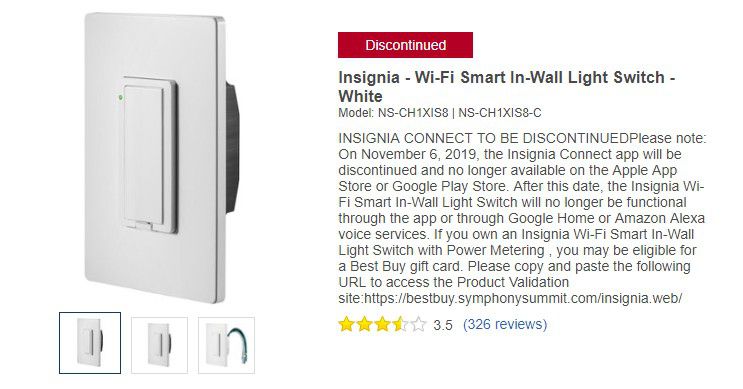Best Buy has quietly announced that the mobile app platform for controlling its Insignia brand of smart home devices will be shutting down on November 6th. The company says affected products will still function at a basic level, but any features that rely on its Insignia Connect app and platform will no longer work. The products include its Insignia smart wall plugs, Wi-Fi light switches, its smart camera, and its Wi-Fi freezer (yes, a Wi-Fi freezer). Best Buy is now running a reimbursement program for any unfortunate soul who decided to buy one of these products.
Perhaps most importantly, Best Buy confirms on its Connect FAQ page that its smart freezer “will retain all normal freezer functions.” There are also variants of the Insignia smart wall plug and light switch that are Apple HomeKit compatible, meaning those specific products will retain some mobile features even after the Connect shutdown next month.
Even if you’re on Android, the plug and switch won’t be entirely useless:
The Insignia Connect app functionality will not work, but any of the scheduled timers that were set up previously, will continue to function. Additionally, the button on the plug will continue to function manually as an on/off switch if needed.
Hope your timers are set right.
Best Buy is also advising any customers who use its Insignia Wi-Fi camera to download stored video clips before November 4th, two days prior to the overall Connect shutdown, or else those clips will be lost forever.
Best Buy says it’s offering reimbursement for purchasing an affected product, with e-gift cards that won’t expire, but it won’t reimburse any installation fees if, say, you paid the Geek Squad to stick some smart light switches in your walls. The company says customers can redeem up to 10 serial numbers for reimbursement through its website.

And to Best Buy’s credit, it doesn’t seem to be selling these products on its website anymore, and they show up as “Discontinued” at insigniaproducts.com. But some of them are still on sale at Amazon.
There are still some other questions. It’s not clear whether you can get fully reimbursed for having purchased a smart home Insignia product that won’t work as advertised two months from now, or just partially reimbursed. Best Buy doesn’t say on its FAQ page to what extent it’s offering these refunds, and whether those refunds extend to any Insignia smart device purchase made at any point in the past, or if there is a purchase cutoff of some sort.
Either way, the situation isn’t ideal for those who’ve bought into the Insignia platform for their smart home needs. This type of quiet shutdown has become an expected and unfortunate trend in the smart home space. Running these platforms in-house can sound like a great, cost-saving idea at first, but doing so over months and years appears to be difficult and costly. Customers are then left hung out to dry when the platforms are inevitably shuttered.
We saw the same exact scenario play out like this earlier this year, when Lowe’s decided to stop supporting its Iris smart home platform and instead send its customers over to Samsung’s Smart Things instead. To placate customers, Lowe’s sent out Visa prepaid cards.
Google similarly decided to close its Works with Nest program in favor of migrating smart home integrations over to Google Assistant earlier this year. The outcome has been messy, to say the least, with Google forced to extend the integration support indefinitely until it can replicate every single one via Google Assistant. A number of other smart home companies have had to scramble after Google’s announcement back in May to ensure nothing would break suddenly when the August 31st deadline arrived.
Of course, putting your smart appliance eggs in a platform basket made by Best Buy is not exactly the savviest of consumer moves. But it shouldn’t be the norm that these software ecosystems are spun up with little thought into how long they’ll last, only to leave customers on the support line clamoring for their money back.





